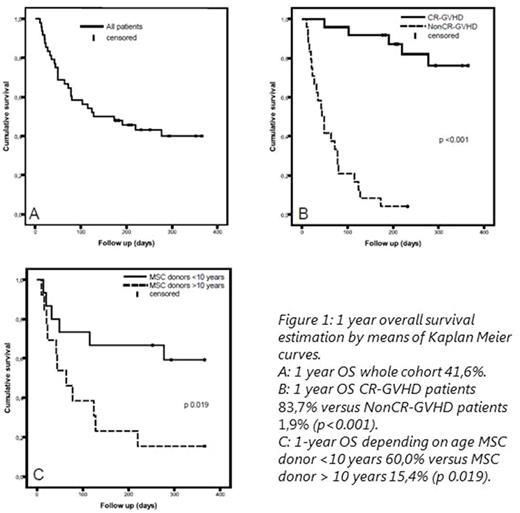Abstract
Introduction
Acute graft versus host disease (aGVHD) remains a life-threatening complication and substantially reduces efficacy of allo-HSCT. In particular, the outcome of patients with severe steroid-refractory aGVHD continues to be poor. Administration of Mesenchymal Stromal Cells (MSC) has been reported by others and us as an interesting treatment option (Le, Frassoni et al. 2008, von, Stolzel et al. 2009, Lucchini, Introna et al. 2010, Te Boome, Mansilla et al. 2015). Though insurance and fast track approval has recently been granted to MSC products in Japan and USA, variability arising from donor variability and the inability to link surrogate markers of the product to clinical efficacy could prove to be a major obstacle in daily clinical practice.
Materials and Methods
We evaluated the impact of individual MSC donors as well as MSC donor properties such as age on clinical response in a cohort of 102 patients with grade II-IV steroid refractory aGVHD treated within a recently reported prospective study as well as an extended hospital exemption program (Te Boome, Mansilla et al. 2015). Bone marrow derived MSC from third party non-HLA matched donors were administered at day 1, 8, and 21 as reported (Te Boome, Mansilla et al. 2015). Primary outcome measures were one year overall survival (OS) and response of GVHD. Cox proportional hazards models, competing risk analyses (Gray's test) and Kaplan Meier estimates were used for analyzing response and OS respectively. Two different R statistical packages for RNA-seq analysis were used for the calculation of differentially expressed genes (DEGs) (DeSeq & EdgeR). The DEGs were considered significant based on the overlap across the two methods and a False Discovery Rate/adjusted p-value<0.05.
Results
102 patients received in total 299 MSC infusions derived from 10 different BM donors. Median number of infusions was 3 (range 1-4). 75,5% of patients received all MSC infusions from the same donor, 20,6% with MSC from 2 donors and 3,9% with MSC from 3 different donors. Two donors were used to treat 28,4% and 43,1% of patients respectively. When testing retrospectively impact on 1 year OS of an individual product no differences between patients treated with either the 2 main contributing donors or the patients treated with the 'other' MSC donors could be observed. However, when donor age was used to cluster cohorts (donor age < and > 10 years) differences were observed (Figure 1) with a survival benefit for patients treated with young donors. Competing risk analysis also revealed a significant benefit for patients only treated with young donors. Furthermore, in multivariate analysis, MSC donor age remained predictive for OS (HR 2,00, p-value 0,025). RNA sequencing analysis was used to further dissect molecular differences between individual donors and allowed to identify a distinctive molecular profile active in MSC that associates with improved clinical outcome.
Conclusions
In our cohort of 102 patients with steroid refractory acute GVHD that were treated with MSC we observed in this retrospective study differences in achieving both complete resolution of GVHD symptoms and 1 year OS. Patients only treated with MSC derived from very young bone marrow donors (<10 years old) had significantly better resolution of GVHD symptoms as well as an improved OS. Furthermore we identified a distinctive molecular profile by means of RNA sequencing that associates with improved clinical outcome. These findings may have implications for current products entering the market approval as well as on both future as well as currently ongoing clinical trials with MSC.
Kuball: Miltenyi: Research Funding; Gadeta (www.gadeta.nl): Consultancy, Equity Ownership, Patents & Royalties: on gdT cells and receptors and isolation strategies , Research Funding.
Author notes
Asterisk with author names denotes non-ASH members.


This feature is available to Subscribers Only
Sign In or Create an Account Close Modal